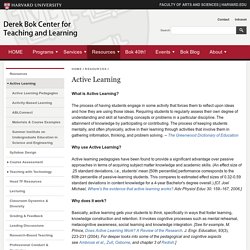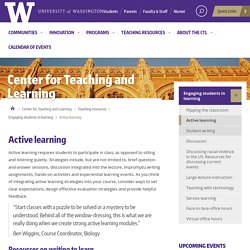

Teaching Strategies. Faculty Focus - Faculty Focus publishes articles on effective teaching strategies for the college classroom, both face-to-face and online. Sign-up for our free newsletter. Active Learning: CTLE Resources. Problem-Based Learning: CTLE Resources. What is Problem-Based Learning (PBL)?

Problem-Based Learning (PBL) is another approach to learner-centered instruction. The instructor (or tutor in PBL-speak) is a facilitator for the learning process, but the entire execution of the PBL experience is student-led. PBL engages students because the real-world problems are determined by student interest and explored in ways the students suggest. The situations they are dealing with are complicated and target student's analytical, critical thinking and problem-solving skills.They are deliberately ambiguous so students have to work hard to arrive at solutions and often they are so multifaceted, that arriving at a solution can present yet another problem to be addressed. The experiential nature of PBL is underscored by the fact that the students have to think and act like real professionals in their respective fields as they work to solve realistic problems. PBL Simplified Visually. Jigsaw: CTLE Resources.
What is the Jigsaw Activity?

A Jigsaw Activity is one that involves all students in the creation and sharing of knowledge independent of the instructor. The instructor is available to provide support and make sure all students are on task, but the responsibility for both teaching and learning belongs to the students. Jigsaw requires two rounds of student grouping. In the initial grouping, students are given some resources (e.g., text, formula, etc.) and charged with getting to know certain information on a particular topic, solving a particular problem or responding to a set of question. Each group has unique information with which to work. How do I design and implement an effective Jigsaw Activity? On a site entitled "Doing CL (Links to an external site.) " Designing the Activity Determine the learning objectives for your lesson.
Grouping Method Assign students to groups using a system that allows for easy regrouping. Monitoring Group Work. An Annotated List of Flipped Class Tools and Resources – Turn to Your Neighbor: The Official Peer Instruction Blog. Flipped Class Tool and Resource List from Turn to Your Neighbor We will keep a (clearly very incomplete) list of tools and resources we use and/or discover relative to flipped teaching here.

Help us grow this list using the form at the bottom of the page. We try to emphasize free tools on this page. There are many paid, inexpensive tools that we are big fans of including Screenflow (screencasting software) and Learning Catalytics (classroom response and assessment system). Turn to Your Neighbor! Hundreds of Tips on Flipped Teaching and Peer Instruction Categorized tips and resources from the daily flipped classroom tip series – #flippedtip on Twitter, curated by @julieschell Some people who do cool stuff with flipped classrooms (very incomplete list in no order, please feel free to send suggestions – find others at flipped learning network and peer instruction network) Methods.
VISIBLE LEARNING - Information About What Works Best For Learning. Active learning. Active learning is a model of instruction that focuses the responsibility of learning on learners.

It was popularized in the 1990s by its appearance on the Association for the Study of Higher Education (ASHE) report (Bonwell & Eison 1991). In this report they discuss a variety of methodologies for promoting "active learning". They cite literature which indicates that to learn, students must do more than just listen: They must read, write, discuss, or be engaged in solving problems. Active Learning. Active learning is a process whereby students engage in activities, such as reading, writing, discussion, or problem solving that promote analysis, synthesis, and evaluation of class content.

Active Learning. Research suggests that audience attention in lectures starts to wane every 10-20 minutes.

Incorporating active learning techniques once or twice during a 50-minute class (twice to or thrice for a 75-minute class) will encourage student engagement. Active learning also: Implementing any new teaching technique can be a daunting or challenging task. Some students may not accept new learning activities with complete ease. Rather than trying to engage all students, focus on engaging more students in more meaningful ways.
Angelo, T.A. & Cross, K.P. (1993). Bonwell, C. Davis, B.G. (2009). Deslauriers L, Schelew E, Wieman C. (2011). Felder, R.M. & Brent, R. (1996). Felder, R.M. & Brent, R. (2009). Active Learning Creating Excitement in the Classroom. Active/Passive. Active Learning - Center for Instructional Technology. Active learning includes any activity in which every student must think, create, or solve a problem.

Below, Dr. Richard M. Active Learning. Active and Coopeative Learning. The past decade has seen an explosion of interest among college faculty in the teaching methods variously grouped under the terms 'active learning' and 'cooperative learning'.

However, even with this interest, there remains much misunderstanding of and mistrust of the pedagogical "movement" behind the words. The majority of all college faculty still teach their classes in the traditional lecture mode. Some of the criticism and hesitation seems to originate in the idea that techniques of active and cooperative learning are genuine alternatives to, rather than enhancements of, professors' lectures. We provide below a survey of a wide variety of active learning techniques which can be used to supplement rather than replace lectures.
We are not advocating complete abandonment of lecturing, as both of us still lecture about half of the class period. Derek Bok Center for Teaching and Learning. What is Active Learning?

The process of having students engage in some activity that forces them to reflect upon ideas and how they are using those ideas. Requiring students to regularly assess their own degree of understanding and skill at handling concepts or problems in a particular discipline. The attainment of knowledge by participating or contributing. The process of keeping students mentally, and often physically, active in their learning through activities that involve them in gathering information, thinking, and problem solving. -- The Greenwood Dictionary of Education.
Center for Teaching and Learning. Active learning requires students to participate in class, as opposed to sitting and listening quietly.

Strategies include, but are not limited to, brief question-and-answer sessions, discussion integrated into the lecture, impromptu writing assignments, hands-on activities and experiential learning events. As you think of integrating active learning strategies into your course, consider ways to set clear expectations, design effective evaluation strategies and provide helpful feedback. “Start classes with a puzzle to be solved or a mystery to be understood. Behind all of the window-dressing, this is what we are really doing when we create strong active learning modules.”Ben Wiggins, Course Coordinator, Biology Resources on writing to learn Learn more. Active learning - Approaches to learning - Learning and ... ActiveLearn: Login. Active learning (machine learning) This article is about a machine learning method.
For active learning in the context of education, see active learning. Let be the total set of all data under consideration. For example, in a protein engineering problem, would include all proteins that are known to have a certain interesting activity and all additional proteins that one might want to test for that activity. During each iteration, is broken up into three subsets : Data points where the label is known.: Data points where the label is unknown.: A subset of that is chosen to be labeled. Most of the current research in active learning involves the best method to choose the data points for , of each unlabeled datum in and treat as an -dimensional distance from that datum to the separating hyperplane. Minimum Marginal Hyperplane methods assume that the data with the smallest are those that the SVM is most uncertain about and therefore should be placed in. ActiveLearn.